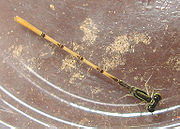
Citrine (colour)
Encyclopedia

Quartz
Quartz is the second-most-abundant mineral in the Earth's continental crust, after feldspar. It is made up of a continuous framework of SiO4 silicon–oxygen tetrahedra, with each oxygen being shared between two tetrahedra, giving an overall formula SiO2. There are many different varieties of quartz,...
, and variously described as yellow
Yellow
Yellow is the color evoked by light that stimulates both the L and M cone cells of the retina about equally, with no significant stimulation of the S cone cells. Light with a wavelength of 570–590 nm is yellow, as is light with a suitable mixture of red and green...
, green
Green
Green is a color, the perception of which is evoked by light having a spectrum dominated by energy with a wavelength of roughly 520–570 nanometres. In the subtractive color system, it is not a primary color, but is created out of a mixture of yellow and blue, or yellow and cyan; it is considered...
ish-yellow, brown
Brown
Brown is a color term, denoting a range of composite colors produced by a mixture of orange, red, rose, or yellow with black or gray. The term is from Old English brún, in origin for any dusky or dark shade of color....
ish yellow or orange
Orange (colour)
The colour orange occurs between red and yellow in the visible spectrum at a wavelength of about 585–620 nm, and has a hue of 30° in HSV colour space. It is numerically halfway between red and yellow in a gamma-compressed RGB colour space, the expression of which is the RGB colour wheel. The...
. Actually, as can be ascertained by inspecting its h value, citrine is a medium dark shade of golden yellow. The confusion about the nature of the colour is caused by the fact that shades of dark yellow (such as olive) tend to appear greenish.
The first recorded use of citrine as a colour name in English
English language
English is a West Germanic language that arose in the Anglo-Saxon kingdoms of England and spread into what was to become south-east Scotland under the influence of the Anglian medieval kingdom of Northumbria...
was in the year 1386.
Citrine in nature


"Citrine" is used as an adjective in the names of birds and other animals with such colouring to describe their appearance, including the Citrine Wagtail
Citrine Wagtail
The Citrine Wagtail or Yellow-headed Wagtail is a small songbird in the family Motacillidae. The term citrine refers to its yellowish colouration. Its systematics, phylogeny and taxonomy are subject of considerable debate in the early 21st century. This is because this bird forms a cryptic...
, Citrine Warbler
Citrine Warbler
The Citrine Warbler is a species of bird in the Parulidae family. The term citrine refers to its yellowish colouration. It is found in Bolivia, Colombia, Ecuador, Peru, and Venezuela. Its natural habitat is subtropical or tropical moist montane forests.-References:* BirdLife International 2004....
, Citrine Canary-flycatcher
Citrine Canary-flycatcher
The Citrine Canary-flycatcher is a species of bird in the Stenostiridae family. The term citrine refers to its yellowish colouration. It is found in Indonesia and the Philippines. Its natural habitat is subtropical or tropical moist montanes.-References:* BirdLife International 2004. . ...
and Citrine Forktail
Citrine Forktail
The Citrine Forktail, Ischnura hastata, is a damselfly of the family Coenagrionidae.-Physical description:This species is 20–27 mm in length, and its hindwing is 11–15 mm long; it is thus considerably smaller than most European members of the genus Ischnura.Adult males have a black head...
.

